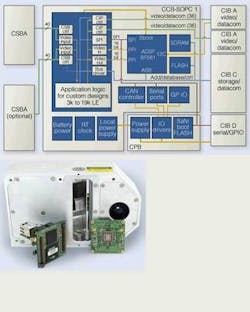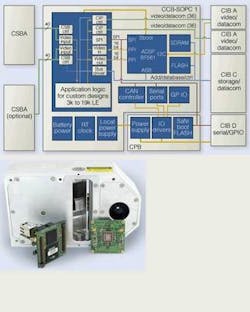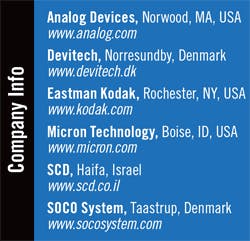Modular cameras make system integration easier
Off-the-shelf and custom modules can be combined for a range of machine-vision applications.
By Andrew Wilson, Editor
To offer the widest range of camera products while minimizing the engineering development time to create them, many camera vendors are following a modular approach in their designs. In essence, this consists of dividing the tasks of image capture, processing, and camera interfacing into separate boards, most often interfaced together using proprietary interfaces. By so doing, developers can offer system integrators multiple series of cameras based on numerous off-the-shelf sensors and interfaces.
After many years of contract development work in the machine-vision industry, Devitech realized that it could leverage its engineering expertise in this way. At VISION 2006 (Stuttgart, Germany), the company debuted a number of camera modules and custom products based on this approach (see figure). “To develop a large range of camera products rapidly,” says Niels Neeser Nielsen, managing director of Devitech, “we developed a modular approach that allows image capture, processing, and camera interfacing modules to be tailored to meet a number of applications.” This modular approach consists of offering several camera-board modules, a common DSP-based processor board, and a series of interface boards.
Because CCD, CMOS, and IR imagers all provide specific benefits, the company offers several camera modules based on these devices. Initially, these will include the MT9M001, MT9T001, and MT9V022 CMOS imagers from Micron Technology and support for the Bird 384 × 288-pixel, 25-µm, 50-frame/s, VOx microbolometer from SCD.
Devitech is also developing a series of camera modules based on the Sony ICX 285 and 274 CCDs. For companies that require other types of CCD image sensors, such as those offered by Eastman Kodak, the company will develop customer-specific boards.
To process images captured from these sensor modules, Devitech has developed a single image-processing board based around the dual-core ADSP BF561 Blackfin processor from Analog Devices. With support for up to 128 Mbytes SDRAM and 8-16-Mbytes flash memory, the processor board interfaces to the camera modules using an on-board gate array.
“As well as allowing a programmable interface to each of the camera modules,” says Nielsen, “the FPGA can process image data in parallel. This is useful when functions such as Bayer color conversion and three-dimensional stereo depth construction need to be performed rapidly.”
RAPID CONFIGURATION
To allow each camera/processing module to be rapidly configured, an on-board EEPROM on the camera module stores device parameters and is used by the DSP/FPGA processor for each setup configuration. This allows the developer to reconfigure device parameters of the sensor using the system’s camera control drivers running under the uClinux operating system (see more at www.blackfin.uclinux.org).
To develop applications for a camera/processing-board combination, the company has manufactured a range of hardware drivers for the uClinux operating system to support the various hardware modules, as well as a library of image-processing functions that include convolution, color conversion, and histogram equalization. Development of applications is done with a set of tools running on a Windows or Linux PC. Applications can be tested and debugged through Ethernet or serial interface directly on the camera/processing module. The final application is transferred to flash memory on the camera/processing module. To interface the board set to a host computer, Devitech offers interface boards that support standards including NTSC/PAL, USB, and Ethernet.
At the VISION show, the company demonstrated a custom laser-based scanner developed for SOCO System. Using a monochrome MT9M001 CMOS image-sensor module, processor board, and Ethernet output, the camera module was integrated with a semiconductor laser and optics generator in a system developed for robot depalletizing.
“To obtain precise rotational accuracy of the plastic boxes being imaged,” says Nielsen, “three structured laser lines are projected onto the edge of the box and the reflection imaged and processed by the camera module combination. Positional coordinates of the boxes are computed in the FPGA/DSP processor and the resulting data transferred to the robot controller over serial interface.” According to Nielsen, the initial cost of developing the product was €40,000. SOCO System is now taking delivery of production units priced at about €4000.
null


